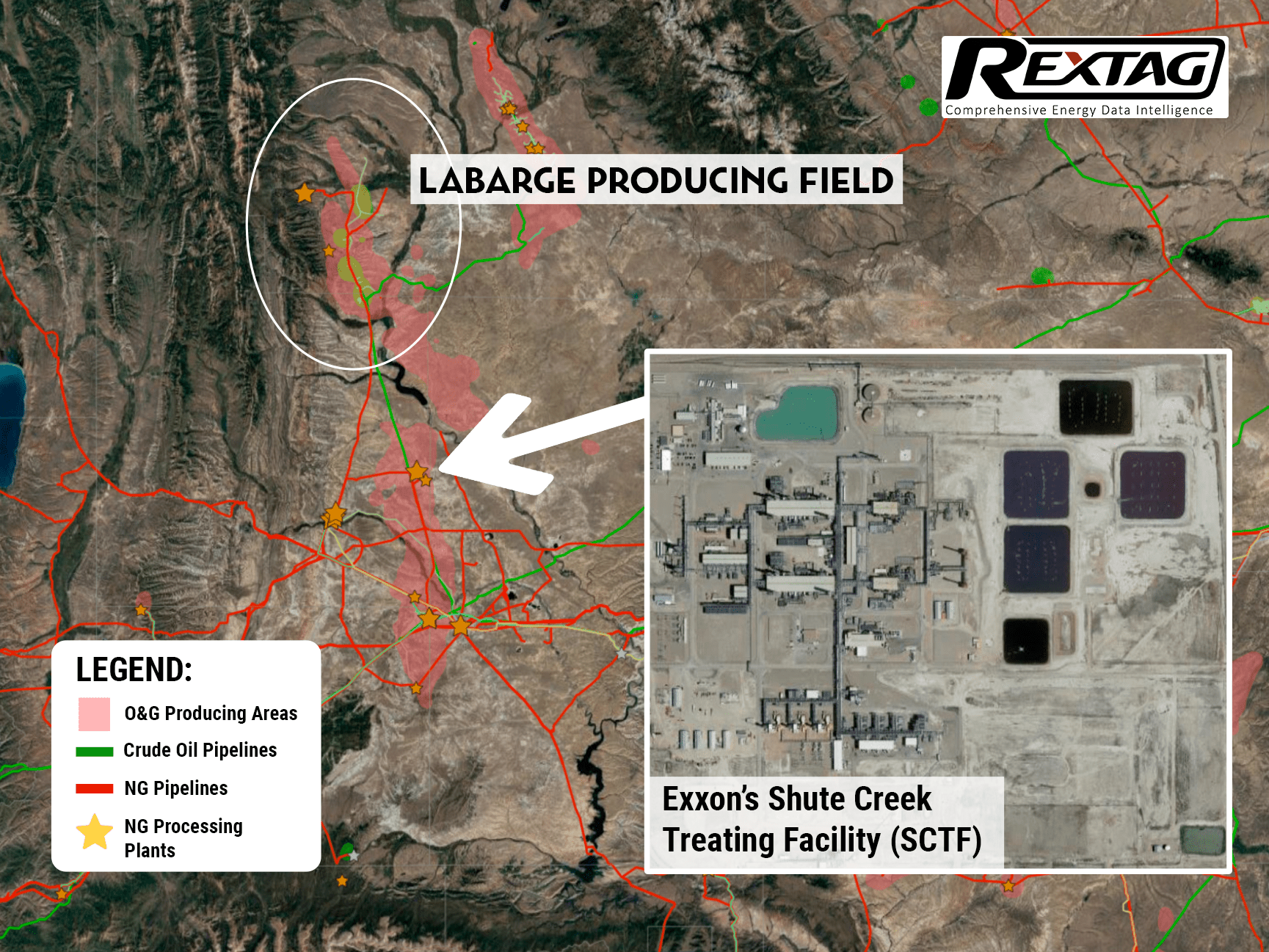Comprehensive Energy Data Intelligence
Information About Energy Companies, Their Assets, Market Deals, Industry Documents and More...
The Hunting Season Is Not Over Yet: Exxon Mobil makes a $400 million commitment to Wyoming's carbon capture
10/25/21
By expanding the facility, Exxon Mobil Corporation anticipates capturing up to 1 million metric tons of carbon dioxide (CO2) more, on top of the 6-7 million metric tons of yearly harvest at the LaBarge facility, Wyoming.
In the Madison reservoir located near LaBarge, Wyoming, Exxon operates two acid gas injection (AGI) wells for the primary purpose of acid gas disposal with a secondary purpose of sequestering CO2 geologically. AGI wells have been operated by ExxonMobil since 2005, and, according to the company's multiple statements, will continue to be injected until the end of the field life of the LaBarge assets.
At the moment, it is one of Exxon's most important bases. Despite the high CO2 concentrations in the gas extracted there, ExxonMobil has been implementing several technologies and approaches from the very beginning to effectively manage the significant volumes of CO2 associated with its production. Carbon capture and storage (CCS) technologies and approaches used at LaBarge are examples of technologies and approaches being proposed for use in other industries.
More so, Exxon Mobil regularly affirms its stance on sustainability in the industry by bringing to life CCS projects like this one around the world. The LaBarge facility is a good example since it already captured more CO2 than any other facility on the planet.
Exxon supports policies that ensure a predictable price for carbon emissions, which can lead to more investments in CCS-type projects. With the right policies in place, this type of technology can be implemented immediately to help society reach its lower-emission goals.
Additionally, as the originator of the Low Carbon Solutions initiative, Exxon Mobil is researching and developing low-emission technology and evaluating several large-scale CCS projects in Europe, Asia, and the Gulf Coast. As well as biofuels and hydrogen, the company is looking at strategic investment opportunities to help bring these technologies to scale for the sectors of the global economy with the highest emissions.
As part of its $400 million investment proposal to expand the CCS capabilities of its Wyoming facility, Exxon Mobil has started the process for engineering, procurement, and construction contracts. Operational activities could begin as early as 2025 after a final investment decision is made in 2022.
At present, about 20% of all CO2 captured worldwide each year is captured at the LaBarge. Yet, in addition to the 6-7 million metric tons of CO2 currently captured at the facility, Exxon anticipates that it can push it even further past the glass ceiling. At the moment, the target is to add a million metric tons to the extraction capabilities of the facility, bringing its yearly total to 8 tons of captured CO2.
However, as one of the largest of the world's Big Oil companies, it is not the only project in Exxon's pipeline: aside from CCS capabilities, the LaBarge is one of the world's largest sources of helium, producing approximately 20% of global supply. Exxon Mobil has also been advocating for additional investments in society's most emitting sectors as part of its sustainability policies.
If you are looking for more information about energy companies, their assets, and energy deals, please, contact our sales office mapping@hartenergy.com, Tel. 619-349-4970 or SCHEDULE A DEMO to learn how Rextag can help you leverage energy data for your business.
The race for landmark CCS project: North Dakota approves Class VI well for Red Trail Energy
![$data['article']['post_image_alt']](https://images2.rextag.com/public/blog/CCS_North Dakota_well_Red_Trail_Energy.png)
New standards for carbon capture have been set in North Dakota earlier this month as NDIC greenlights Red Trail Energy’s project. The company will now be able to commercially capture, compress, and inject 180,000 tons of carbon dioxide per year into the Broom Creek Formation on its property for permanent geologic CO2 storage. This ensures that carbon dioxide can be stored safely for generations to come.
Chord Energy Corp. Expands Williston Basin Footprint with $375 Million Acquisition from Exxon Mobil
![$data['article']['post_image_alt']](https://images2.rextag.com/public/blog/160Blog_Chord Energy Corp to acquire Williston Basin acreages.png)
Chord Energy Corp.'s subsidiary has entered into an agreement to purchase assets in the Williston Basin from Exxon Mobil, and its affiliates for $375 million. Chord Energy, a US independent company, is strategically expanding its presence in the Williston Basin of Montana and the Dakotas. While industry attention remains fixated on the Permian Basin, Chord Energy recognizes the potential of the Williston Basin and is capitalizing on the opportunity to enhance its reserve portfolio. Chord Energy successfully completed the acquisition of 62,000 acres in the Williston Basin from XTO Energy for a substantial cash consideration of $375 million.
![$data['article']['post_image_alt']](https://images2.rextag.com/public/blog/328_Blog_Why Are Oil Giants Backing Away from Green Energy Exxon Mobil, BP, Shell and more .jpg)
As world leaders gather at the COP29 climate summit, a surprising trend is emerging: some of the biggest oil companies are scaling back their renewable energy efforts. Why? The answer is simple—profits. Fossil fuels deliver higher returns than renewables, reshaping priorities across the energy industry.
![$data['article']['post_image_alt']](https://images2.rextag.com/public/blog/327_Blog_Oil Market Outlook A Year of Growth but Slower Than Before.jpg)
The global oil market is full of potential but also fraught with challenges. Demand and production are climbing to impressive levels, yet prices remain surprisingly low. What’s driving these mixed signals, and what role does the U.S. play?
![$data['article']['post_image_alt']](https://images2.rextag.com/public/blog/326_Blog_USA Estimated Annual Rail CO2 Emissions 2035.jpg)
Shell overturned a landmark court order demanding it cut emissions by nearly half. Is this a victory for Big Oil or just a delay in the climate accountability movement?